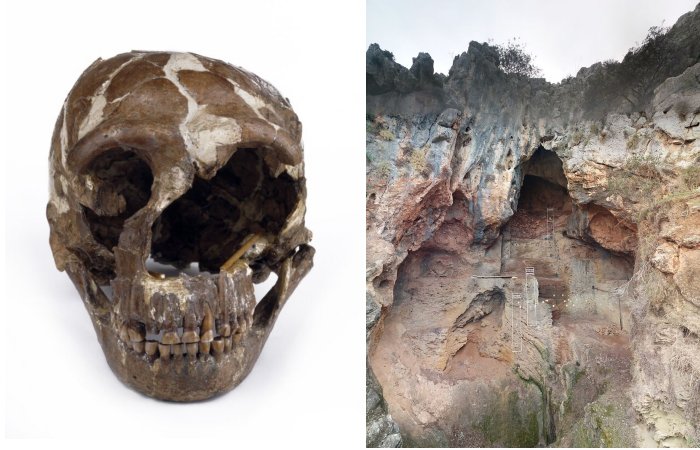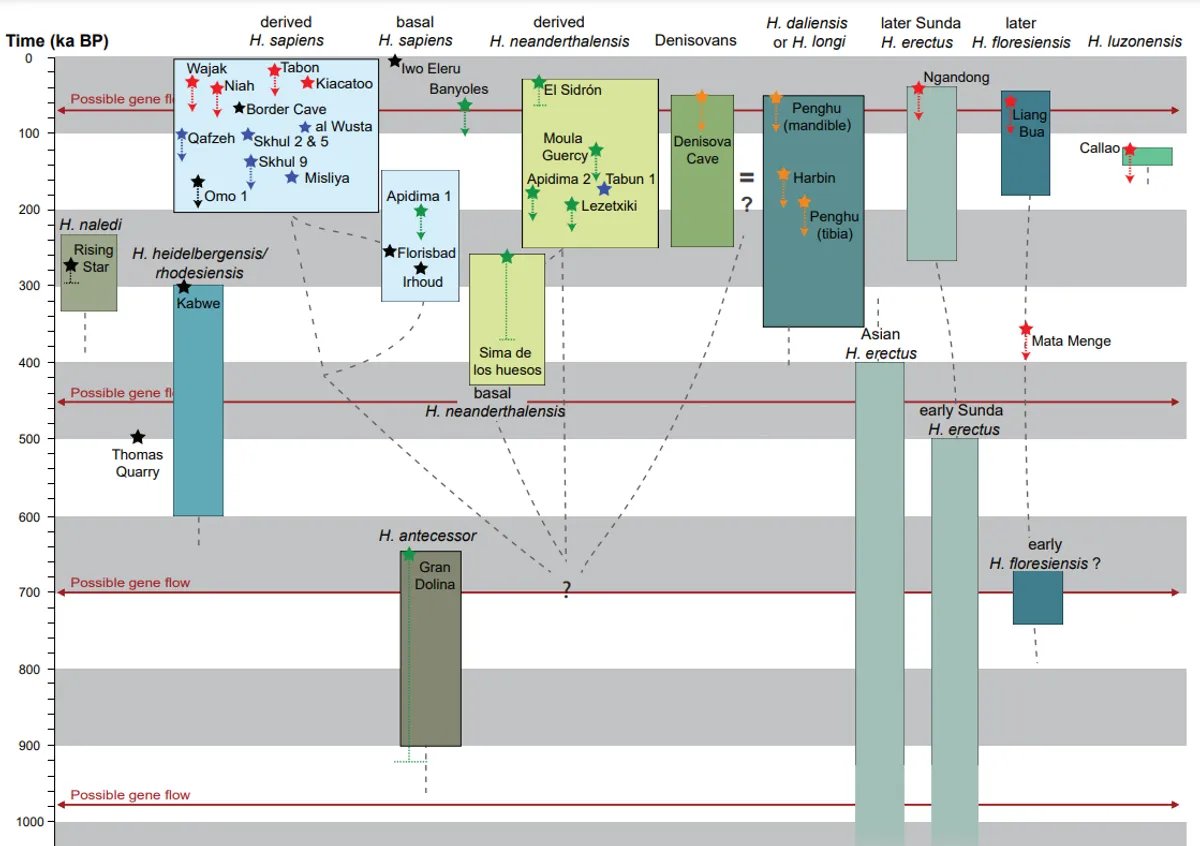Jan Bartek – AncientPages.com – New dating analysis of existing human remains found worldwide has raised questions about some of our current histories of human evolution.
The existence of early Homo sapiens in Europe was over 150,000 years earlier than first thought.

Homo neanderthalensis cranium from the Tabun Cave Israel. Credit: NhM – Right: Tabun Cave, Israel. Credit: Greg Schechter – CC BY 2.0
The application of modern dating methods to fossil human remains has catalyzed major revisions in our understanding of human evolution. In a new review published in the journal Quaternary Science Reviews, Rainer Grün of the Australian National University in Canberra and Chris Stringer at the Natural History Museum, London, show how the reanalysis of fossils discovered across the world brings into question our current ideas of human evolution, some of which may be incorrect.
Paleoanthropological study has traditionally been difficult with a history of contradictory evidence. Traditional methods of dating rely on either the decay of radioactive elements, especially radiocarbon dating, which is only effective on fossils younger than 50,000 years, or the analysis of sediment within which fossils were discovered. The limitations of the latter method were shown with the redating of Homo floresiensis which, although originally placed at less than 20,000 years old, was found to be over 60,000 years old when directly dated. This discrepancy was caused by the excavation inadvertently dating much younger sediments that lay close to the floresiensis skeleton.
The co-authors of this new study instead made use of direct uranium-series dating, which measures the proportion of uranium isotopes in fossils and can date specimens which are hundreds of thousands of years old. Originally a demanding method of analysis involving the sectioning of sometimes crucial specimens, Grün, and colleagues developed pinpoint ways to access the insides of fossils, limiting structural damage, to allow for these more accurate and revealing readings.
Professor Chris Stringer, Research Leader at the Natural History Museum in London, said: “The problem with bone is that it’s an open system. Uranium can get into the bone, allowing it to be dated, but more can also be added or washed out over time. Previously, you might need to cut a fossil in half and track the uranium all the way through the bone, but this wasn’t feasible on valuable fossils such as the ones we were reanalyzing. Instead, Rainer has helped to miniaturize the process so that tiny samples can be taken using lasers to minimize damage to important areas of the specimen.”
Professor Rainer Grün, Emeritus Professor at the Australian National University in Canberra, said: “This paper is a summation of our mutually complementary research collaboration and friendship over the last 37 years. Some of these findings are astonishing, but provide an excellent outlook for increasing our understanding of human evolution.”
One such piece of groundbreaking evidence highlighted in this study was the Apidima Cave in Greece, in which two partial crania were discovered. Anatomically, these appeared to belong to two different species – an early Neanderthal and an early Homo sapiens.
U-series dated the Homo sapiens specimen at 40,000 years older than the Neanderthal remains, which some scientists found difficult to accept as chronologically, Neanderthals were seemingly present in Europe long before Homo sapiens. Some argued that the fossils were deposited together and thus more likely to represent a single population of Neanderthals with some distinctive features.
Following Grün and Stringer’s further analyses presented in the paper, they showed that the sapiens and Neanderthal specimens were originally deposited within different geological environments and then subsequently redeposited together. Therefore, the Homo sapiens fossil was indeed present in Europe at least 210,000 years ago, over 150,000 years earlier than previous ideas on when Homo sapiens first migrated to Europe and the oldest Homo sapiens fossil found in Europe so far.
Similarly, further analyses of the remains found in Callao cave in the Philippines in 2010 have shed new light on the supposed age of the mysterious Homo luzonensis – a new human species at the time of discovery. Upon initial anatomical analysis, the remains were dated to ~65,000 years old.

Credit: NHM
These fossils are now shown to be at least 130,000 years old on further analysis, about twice the age given in existing literature. The previous age estimates suggested H. luzonensis could have co-existed with early H. sapiens in the region, while the new dating makes that less likely.
To build on this impressive research, the scientists hope that more in the field will now go back and extend the dating work on these and other fossils.
However, despite analyzing hundreds of remains at existing sites across Europe, Africa, Asia, and Oceania, more work must be done to find new sites containing early human fossils. Areas such as Arabia, the Indian subcontinent, southeast Asia and central and west Africa have not been as thoroughly investigated, and yet are crucial to further our ongoing understanding of mapping the history of our ancient relatives.
‘Direct dating of human fossils and the ever-changing story of human evolution’ is published in the journal Quaternary Science Reviews.
Written by Jan Bartek – AncientPages.com Staff Writer





